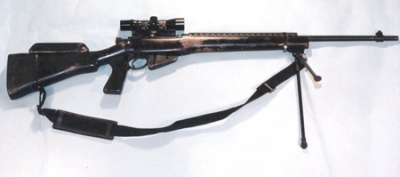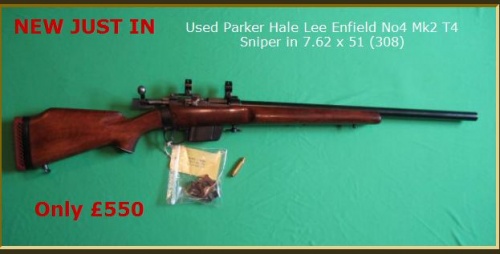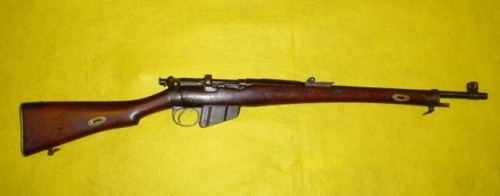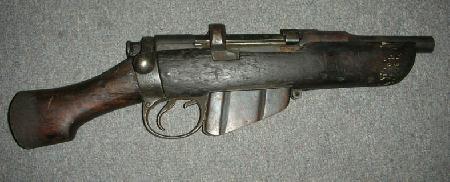| If you have been locked out of your account you can request a password reset here. |
Talk:Lee-Enfield rifle series
Additional Variants
Screen-Used Variants

Discussion
The SMLE is a specific variant of the Lee-Enfield used in WW1 and early WW2, also known as the No.1 Mk.III. Seeing as alot of the time the rifles in these movies and games are actually No.4s, maybe it would be better to call this article "Lee-Enfield RIfle" and separate it into sections for the various models, like was done with the M-16? - Nyles
- That sounds like a wonderful idea, fi I do say so myself. If nobody objects by this time tomorrow, then I'll move this page to "Lee-Enfield rifle series". Sound good? Pyr0m4n14c (talk) 15:13, 4 March 2018 (EST)
- Actually, first I should ask: Does moving a page preserve its redirects, or do I have to re-create the redirects if I move the page? Pyr0m4n14c (talk) 20:10, 23 March 2018 (EDT)
- After moving the page, you'll have to modify the existing redirects to reflect the new page name, or else they'll be double redirects. --Ultimate94ninja (talk) 20:18, 23 March 2018 (EDT)
- Oh, okay. If you don't mind me asking, how does one do such a thing? I'm not very well-versed in wikitext and the like. (Hell, it took the better part of a year for me to figure out how to make images work...) Pyr0m4n14c (talk) 09:46, 24 March 2018 (EDT)
- Here, you edit the hyperlinks that have "(redirect page)" after them. --Ultimate94ninja (talk) 13:21, 24 March 2018 (EDT)
- Thanks, I'll get on it right away. Pyr0m4n14c (talk) 21:01, 24 March 2018 (EDT)
- Here, you edit the hyperlinks that have "(redirect page)" after them. --Ultimate94ninja (talk) 13:21, 24 March 2018 (EDT)
- Oh, okay. If you don't mind me asking, how does one do such a thing? I'm not very well-versed in wikitext and the like. (Hell, it took the better part of a year for me to figure out how to make images work...) Pyr0m4n14c (talk) 09:46, 24 March 2018 (EDT)
- After moving the page, you'll have to modify the existing redirects to reflect the new page name, or else they'll be double redirects. --Ultimate94ninja (talk) 20:18, 23 March 2018 (EDT)
- Actually, first I should ask: Does moving a page preserve its redirects, or do I have to re-create the redirects if I move the page? Pyr0m4n14c (talk) 20:10, 23 March 2018 (EDT)
Current USE?
From what I know, no 'front line' terrorist (I refuse to dignify them by calling them insurgents) uses the SMLE, even in Afghanistan. Some tribal villagers do hold and carry them, but they're private individuals. I asked three Army commanders who were in both Iraq and Afghanistan, and the only time they ever saw SMLEs were in piles of old stashes of weapons, rusting, and they were extremely rare. Most of the enemy weapons are AKs and other Soviet weaponry. So I would not consider the SMLE as a weapon currently being used by a recognized force. Please, opinions on this anyone? MoviePropMaster2008 18:41, 20 November 2008 (UTC)
- I never seen any insurgents or terrorists using SMLEs in my life.User:Oliveira
- I agree. I brought it up because a contributor wrote "the rifle is still seeing use in the hands of enemy combatants in both Iraq and Afghanistan against US and Allied military forces." Personally I've never seen an enemy combatant (after the early 1980s during the Russian invasion) using Lee Enfields and certainly not NOW during the 21st century. I brought it up the first time because I am interested in seeing what proof the original writer had for that statement. Could be just a brain fart. Lord knows I've written those myself on IMFDB in the past ;) MoviePropMaster2008 09:04, 22 November 2008 (UTC)
MPM2008 and co.
Here's some links regarding the current use of the Lee-Enfield rifle in the Middle East and South Asia.
http://www.military.com/NewsContent/0,13319,137040,00.html?ESRC=army.nl
http://www.strategypage.com/dls/articles/200871212157.asp
P.S. MPM2008. Thanks for posting up those Lee-Enfield pictures. I really like those pictures and the other gun pictures you've posted in recent times. User:Roughneck Jase
- Thanks for the compliment and the links. BUT... these links actually support my initial point that the Enfields aren't being used by active combatants in Iraq OR Afghanistan any more. I'm a Vet of ODS and I have LOTS of friends who are actively serving or served during OEF or OIF and everyone said that they found caches of old weapons, at NO TIME have any hostile forces ever used these antiquated weapons in a combat action. Why would they? They have tons of full auto AKs, RPKS, PKMSs, RPGs, etc. Again, I stand by my assertion that, though people dig up buried caches of antique weapons all the time in Afghanistan and Iraq, that's exactly what they are, "Caches of Antiques", not weapons any active terrorist would use. In fact the only enemy snipers encountered in Iraq used either Dragunovs, Romanian PSLs or the Iraqi Tabuk Rifle. I say over and over again, NO Enfields are being used by anyone as a front line weapon any more. They ARE all over the place in family collections in Baghdad or used by Goat Herders in the mountains of Tora Bora, but that's civilian ownership, not an active combat rifle. Running into an 80 year old tribal goat shepard with an Enfield, doesn't count towards that rifle being a 'battle weapon'. And certainly finding piles of them buried in the sand doesn't count either. I hope people kinda understand what I'm getting at. :) And thanks for the links and comment. MoviePropMaster2008 04:53, 30 November 2008 (UTC)
MPM2008,
Let's just say that we "agree to disagree" about the Lee-Enfield's current use in todays battlefield's in the Middle East and South Asia. What I'm trying to say is that rifles like the Lee-Enfield are among the many weapons at the disposal of various waring factions and insurgents in the Middle East and South Asia and if I was an Australian soldier (I'm an Aussie BTW) serving in either Iraq or Afghanistan, I wouldn't underestimate an insurgent armed with a rifle like the Lee-Enfield (or the Mauser 98 or the Mosin-Nagant). Besides, rifles like the Lee-Enfield are still potent infantry rifles by today's standards. User:Roughneck Jase
- I think you're missing the point. No one discounts the usefulness of the enfield. He said that they were not used in combat, just owned by people. Like the .22 rifle (1022 ruger) is owned all over the U.S. by people, cops, soldiers, but it's not considered a combat rifle of the USA though it has been used in the past (the silenced version) for covert OPs. I've never heard of any of the warring factions actually using the Enfiled anymore either.
I've heard the SMLE and other full-power rifles (Mausers and Mosin-Nagants) have been used more frequently in Afghanistan because the bullets are more likely to penetrate the body armour worn by Western troops. And the extra range over an assault rifle is an advantage too. Wraith
Enfield Enforcer
Shouldn't that article be merged with this one? I mean it's the same rifle only with a caliber conversion? Rockwolf66 05:54, 24 March 2009 (UTC)
Lee Enfield is not that good.
I really don't understand why people think the Lee Enfield is such a great gun, when you compare it to the Mauser 98 it's just not that good. Here is one reason why this is true http://books.google.com/books?id=TM9YS52R34AC&pg=PA179&lpg=PA179&dq=mauser+lee+enfield+military&source=bl&ots=74eS9rbmZo&sig=Ez0ojuyBXFYP3elaVQACpTwkbcQ&hl=en&ei=jz7ySdWeMZ-stgeu_qSjDw&sa=X&oi=book_result&ct=result&resnum=4 . The Lee Enfield is an underpowered rifle , it uses a rimmed cartridge , the bolt action is only slightly faster than a Mauser type (it would need to be measured in milliseconds), the bolt action is not as strong as the Mauser type, its ten round mag still needs to be loaded by 2 stripper clips, its rimmed cartridge can cause many problems with the rifle, the Lee Enfield is bulkier than the Mauser type, its feeding and extraction is not as good as the Mauser type, it is not as accurate, it is not as reliable, the Mauser rifle series has 102 million military rifles built from 1871 to the 1950's, and that is not including all of the modern hunting and military sniper rifles built right now. There are still many more reasons why the Lee Enfield is not as good as the Mauser type.
sure you might have a argument but to be honest just about no one on here cares
Who you talking to. Me or the LE hater?--Jcordell 09:22, 9 December 2009 (UTC)
- Mauser Guy: the points you make seem pettifogging (e.g.:"underpowered"? A .303 round? You've got to be kidding!). Not only since these are obsolete weapons (from the military standpoint), but because both rifles did their job in the trenches of the Great War, slaughtering German, French and British troops in the hundreds of thousands, as well as during its conclusion (i.e. WWII) and beyond. Though I doubt any German soldier would have wanted to face an M-1 Garand--let alone a Tommy Gun or a PPSh--with his Mauser!
- If Call of Duty 5: World at War has it right, soldiers carrying bolt action rifles (excepting snipers of course) were at a serious disadvantage against troops with more "modern" weaponry. As Martin Dougherty puts it: "[The self-loading rifle] has proven [itself] many times over in urban, jungle and hedgerow actions (i.e. the bocage country in Normandy)."
- PainMan356 07:11, 15 December 2010 (UTC)
- PainMan356: Here's a link that I found on the good ol' Internets a while back in what kind of guns the Taliban insurgents are currently using on a regular basis...
http://atwar.blogs.nytimes.com/2010/09/15/whats-inside-a-taliban-gun-locker/
It goes to show that the Lee-Enfield (and the Mosin-Nagant) is still seeing action in Afghanistan today. Take that you Mauser fanboy! User:Roughneck Jase 17:36PM AEST, 15 December 2010.
I take it the first poster has never used a Mauser or a Lee-Enfield in service type shooting competition. The Lee-Enfield is SIGNIFICANTLY faster in bolt operation than a Mauser. I know from using both types. The Swedish M96 (cock-on-close) is almost as fast as a Lee-Enfield and is still noticeably faster than a Mauser 98 (cock-on-open). In a rapid-fire course, my M48 (still in fairly new condition with less than several hundred rounds fired) could only get 2 shots fired in the same time a Lee-Enfield would fire 3 or 4 rounds. Note that these timings include working the bolt for the first shot. The Mauser has a 90-degree bolt-rotation VS the 60-degree bolt rotation on a Lee-Enfield. This doesn't sound like much but it makes a big difference in rapid shooting. In a mad-minute match, I was able to fire 27 rounds in 60 seconds from a (borrowed) SMLE. This included a standing start and the rifle at my feet with the bolt closed, and on top of that reloading from clips during the course (distance was 200 metres). In the same conditions, the M48 would have been lucky to fire 15 rounds. There's an old saying among service rifle shooters: The Springfield is a target rifle, the Mauser is a hunting rifle, the Lee-Enfield is a battle rifle! Wraith
- The sights on the Mk III left a lot to be desired, but sights on the No. 4 are great. The battle sights are nice enough, the ladder sights are even better. --funkychinaman 03:23, 16 December 2010 (UTC)
- I agree the Mk1 Singer back sight on the No4 is the second best issue sight on a pre-1950 service rifle. The M1 Garand is only better because of the windage adjustment. The Mk2 flipover (300/600, and 200 with the bayonet attached) is worse than any of the SMLE sights. And the Mk3 and 4, while giving elevation in 100 yard adjustments, rely too much on your ammunition matching the sights. The Mk1 with 1MOA clicks is brilliant. Only a Central or Rawson target sight is better. The best SMLE back sights are the ones with fine elevation and windage adjustment made before WW1 and between the wars. You get used the sights on a SMLE after a few shots. Wraith
A retort to our Mauser fan
The extractor claw on the Mauser 98 bolt head would fill up with dirt at times in the conditions of the trenches. That could be an issue if the soldiers weren't on top of it. Also the Mauser actions cocks on opening. Once again the conditons found in the trenches coud play into that design. There are accounts of the Mauser being rather balky when a soldier went to open it in a hurry. The Lee Enfield cocked on closing. In the dirt and general nastiness of the trenches the LE design was found to be more reliable.
The old 7.92mm Mauser round was/is more powerful than the .303 British,but not enough to make a difference.For example Canadians have been killing Moose, Elk, Caribou, bear and even the occassional Grizzley with the .303 for decades. How do you consider that to be underpowered? I'm here to tell you that all those animals take a whole lot more killing than a human being. Hell there were even British hunters who took elephants and lions in Africa with the .303 in the late 19th and early 20th century. I only mention this because you seem to be focused on the sporting application vs. combat application.
The Mauser is a great design and is a terrific base for a sporting rifle. Very strong and accurate.Yes it will "outsnipe" the LE but whne you're talking combat the differences aren't all that significant. The LE is a better Combat design. Your points are valid but they apply more to hunting and target then combat. The old L4A1 sniper pattern of the No. 4 was also very accurate. It wasn't a Winchester Model 70, but it worked well enough for the SAS in Yemen in the seventies.
The various Commonwealth soldiers knew about the loading issue when it came to the .303 rimmed design. They ensured that the bullets were loaded into the stripper clips properly. And in my opinion ten rounds is still better than five rounds. You still have double the ammo. It's interesting that you had to stretch and say that the LE soldiers "only" had ten rounds in their magazine at the beginning of an action.
I think what it really comes down to is you're a fan of the Mauser design. So am I, but I don't instantly disregard another design. The LE provided honorable service to the Brits and the other Commonwealth nations for sixty plus years. Actually more because India used it into the seventies.Would it really have lasted that long if the LE design was as poor as you said? I think not. --Jcordell 05:44, 27 July 2009 (UTC)
Well I guess the Mauser fan didn't want to play. I've been waiting for over four months. Oh well.--Jcordell 04:06, 9 December 2009 (UTC)
Error regarding "Lee-Enfield Mark III"
The weapon labeled "Lee-Enfield No.1 Mk.III*" is, in fact, properly named the "SMLE Mk II" (or Short Magazine Lee Enfield), also known, amongst the soldiers who used it, as the "Smellie".
This has been corrected. I can produce an illustration (albeit a copyrighted one) from the book listed below to prove that I am correct.
My source:
Small Arms: From the Civil War to the Present Day by Martin J. Dougherty (Fall River, 2005), page 81.
Also, the assertion that the Lee-Enfield could fire up to 30 rounds a minute is not tenable. Sir John Keegan, the world's leading military historian, writes that 15 rounds a minute was the rate of fire achieved by British troops in combat. And given the Royal Army's justly deserved reputation as a "guild of sharpshooters" it is unlikely that any other troops have ever achieved such a high rate of fire with a bolt action rifle--especially untrained, or badly trained, guerillas, terrorists and "insurgents" and soldiers.
Example: During the Falklands War, both sides used the FN FAL. The Argentines used a fully automatic version while the British troops used a semi-automatic version and defeated their enemy in every infantry encounter. Thus fully vindicating the Royal Army's rep for superior marksmanship. And quick trigger fingers!
PainMan356 07:00, 15 December 2010 (UTC)
OK, first, it's not the Royal Army. Second, 15 rounds/minute was the rate that British soldiers were expected to achieve, most could do more (The Enfield holds the world record for aimed bolt-action fire - 38 rounds in one minute at a 12-inch target 300 yards away). From an article on the BBC History website:"In his annual musketry course the infantryman fired 250 rounds at targets up to 600 yards away, and this included the ‘mad minute’ in which men had to fire 15 rounds at a target 300 yards distant. Most could do rather better than that, and some could fire almost 30 rounds a minute with little loss of accuracy." (Source) Also, could you post your source that shows the image (which was taken and listed by a professional armourer) is a Mark II and not a Mark III* please? The Wierd It 11:37, 15 December 2010 (UTC)
- I rolled back the changes that PainMan356 made to the page. Sent him a message telling him he needs to show his reference. Think he knws that the Mk III* are actually labeled that way on the rifles themselves? --Jcordell 18:36, 15 December 2010 (UTC)
- The rifle has been known, at various points, as the ShtLE Mk.III, SMLE Mk.III and Lee-Enfield No.1 Mk.III. The Mk.II was a Boer War era Lee-Enfield Mk.II converted to SMLE Mk.I specs, and the rifle on the site is most definately not in Mk.I configuration. Also, the British soldiers ability to perform the "mad minute", often at rates exceeding 15 rounds a minute, dates back to before WW1. The destruction of the pre-war professional British army in 1914/1915 really put at end to that particular level of skill. - Nyles
- I rolled back the changes that PainMan356 made to the page. Sent him a message telling him he needs to show his reference. Think he knws that the Mk III* are actually labeled that way on the rifles themselves? --Jcordell 18:36, 15 December 2010 (UTC)
My understanding of the 'No' designations is that the term Lee-Enfield etc doesn't appear in the official designation, so that (for example) the 'SMLE Mark III' was re-designated (in the 1920s) as the 'Rifle No1 Mk III'. The No4, by comparison, didn't have an old-style designation, only being developed in the 1930s. Regarding rates of fire, the 1929 Textbook of Small Arms (which, admittedly, might be slightly partisan) has the following quotes: 'It is possible to deliver roughly directed fire at the rate of 60 rounds a minute, a rate which is often attained and sometimes passed in routine tests on the range of the Small Arms Ammunition Inspection Department', and 'In rapid fire from the shoulder at the rate of 60 rounds in 60 seconds, the firer has been injured, but not severely, several times by a cartridge exxploding after he had opened the bolt' (that is raised in the context of the problem caused by hangfires). IKD 16 Feb 2011
MLE vs. Lee-Metford
Is the MLE just a Lee-Metford adapted to smokeless powder? --Funkychinaman (talk) 01:28, 4 April 2014 (EDT)
The Lee-Metford rifles had a Metford-designed rifled barrel to accommodate the older .402 caliber cartridge. When the Lebel 1886 came out, with it's 8mm smokeless cartridge, That's when the development of the .303 Cordite round began. Unfortunately, the Metford rifling was not able to handle the smokeless cartridge without breaking, thus Enfield designed rifling suitable enough for the .303 Cordite cartridge. If you want more info on this, here's a link to C&Rsenal's video on the Long Lee Enfields: --50AEDeagle (talk) 11 March 2017
- Just to clarify for anybody who wants to tell them apart in media, if you get a good shot of them you normally can tell them apart, the only exception is the MLM Mk II* and the MLE Mk I which are identical apart from the rifling change. All of the earlier MLM lacked the safety on the cocking piece, the only exception is the Mk II* so, if it has the safety it is relatively safe to say that it is an Enfield rather than a Metford. --commando552 (talk) 17:13, 11 March 2017 (EST)
Breaker Morant article, need advice
Hey all you Lee-Enfield experts, I need an opinion on the question I asked in the "Breaker Morant" movie talk-section. Dudester32 (talk) 14:56, 4 February 2015 (EST)
Grenade Launchers
Could the WWI-era SMLE cup grenade launchers be used on No.4 Lee-Enfields? Pyr0m4n14c (talk) 11:46, 4 August 2017 (EDT)
- No, it locks into holes on the nose cap of the SMLE and the No.4s are built completely differently. You could still technically use the rod type grenades, but you wouldn't be able to fit the cradle to keep the spoon in (which was held against the SMLE nosecap by the fixed bayonet) so you would have to quickly pull the pin and fire before it blew up in your face. These SMLE grenade launchers were actually still used all the way through WW2, with them wrapping the stocks with copper wire to strengthen them and using them as dedicated grenade launching weapons. Not sure, but i don't think there actually was a grenade launcher for the No. 4 during WW2, I believe the 22mm spigot type launcher was post-war. --commando552 (talk) 15:52, 4 August 2017 (EDT)
Sniper Scopes, Enfield Rifles WW2 Era
So far I have found out that the following sniper scopes were used in WW2:
No. 32 Mk.I No. 32 Mk.II No. 32 Mk.III No. 42 Mk.I
All No. 32 variants used the same reticle, magnification and field of view as far as I know (3x Magnification, FOV 8,5°). I also definitely know that those were used in WW2. Then comes the No. 42, which I just found out recently, is said to have been used in WW2 too, but I have never seen any proof of this, so what do you guys think? I found a photo of the reticle, which is just a single horizontal hair line, seems rather strange, how would you aim with that? Also does anybody know the characteristics of this scope? I am somewhat confused about the No. 42... --Hchris (talk) 12:45, 30 September 2017 (EDT)
Asterisk
What's with the asterisk in "Lee-Enfield No.1 Mk.III*"? I notice none of the other rifles on the page have it in their name. Spartan198 (talk) 20:07, 7 July 2019 (EDT)
- A bit late for a reply, but IIRC the asterisk (read "star") in British weapon desginations indicates a model that has been improved or updated. Could be wrong though. --Dan San (talk) 23:37, 14 August 2020 (EDT)
- Yeah, it is basically a minor improvement to an existing model that doesn't warrant a new Mk number. The origin of the star is that it was normally added to existing weapons when they were modified to a new standard so it was easy to tack something on to the end of the markings. They are not always modified existing guns though, some are new manufacture with the star already. You can also get multiple stars if the gun has seen multiple improvements, for example the SMLE Mk. 1 went all the way to the Mk. 1 *** as they were continually upgraded. --commando552 (talk) 05:04, 15 August 2020 (EDT)
Specifications must be written for each model separately, as they are very different. It is also strange that there is no SMLE MkI, since this actually forms a gap in the model range. --Slon95 (talk) 12:43, 14 December 2021 (EST)



















